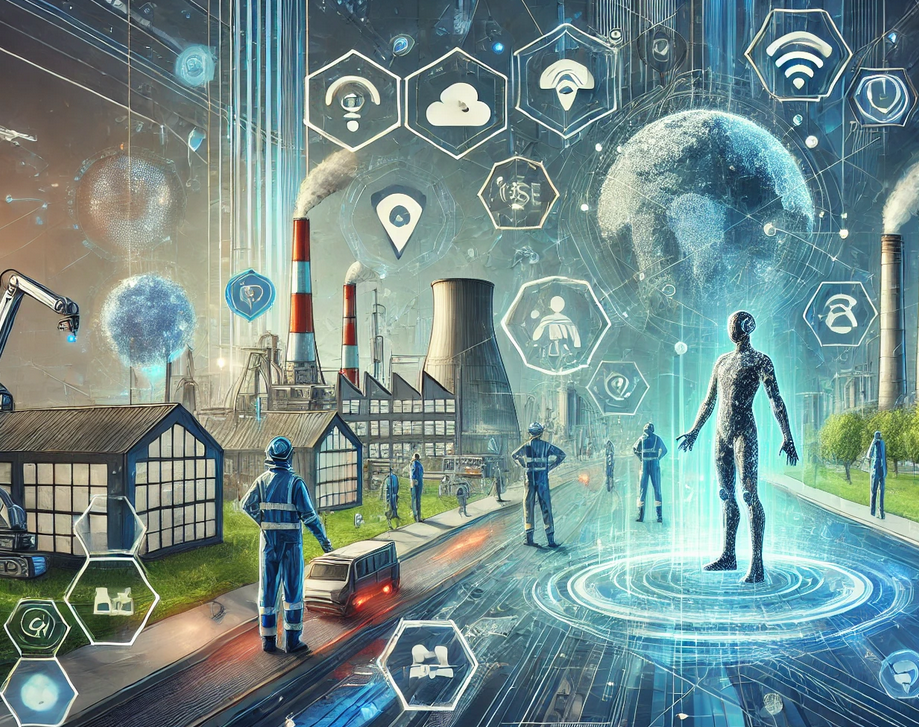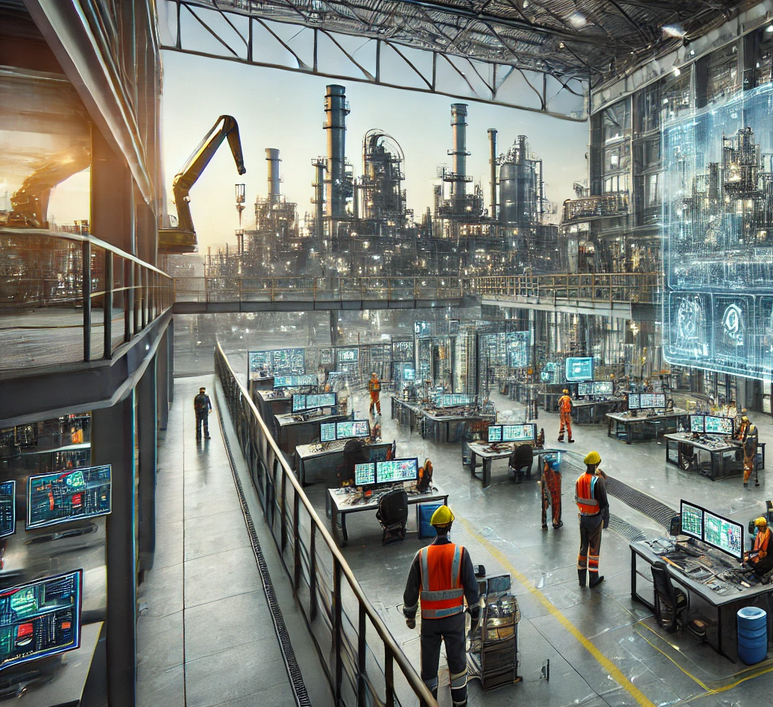- Introduction
- The Rise of AI in OHSE
- DeepSeek: A Game-Changer in OHSE
- Predictive Analytics for Hazard Prevention
- Wearable Technology and IoT in OHSE
- Virtual Reality (VR) and Augmented Reality (AR) for Safety Training
- AI-Driven Environmental Monitoring
- Mental Health and AI
- Challenges and Ethical Concerns
- The Future of OHSE: AI and Beyond
- Conclusion
- References and Further Reading
Introduction
AI Transforming the Industry : The world of Occupational Health, Safety, and Environment (OHSE) is undergoing a seismic shift. As workplaces become more complex and regulations more stringent, organizations are turning to cutting-edge technologies to ensure the safety and well-being of their employees.

Among these technologies, Artificial Intelligence (AI) stands out as a game-changer. From predictive analytics to wearable devices, AI is revolutionizing how we approach workplace safety.
In this article, we’ll explore how AI, along with technologies like DeepSeek, is transforming OHSE. We’ll delve into real-world applications, emerging trends, and the challenges of integrating AI into safety protocols.
Whether you’re a safety professional, a business leader, or simply curious about the future of workplace safety, this article will provide valuable insights.
The Rise of AI in OHSE
What is AI, and How Does It Apply to OHSE?
Artificial Intelligence (AI) refers to the simulation of human intelligence in machines that are programmed to think, learn, and make decisions. In the context of OHSE, AI is being used to:
- Predict and prevent workplace accidents.
- Monitor employee health and environmental conditions in real-time.
- Automate routine tasks like incident reporting and compliance checks.
For example, AI-powered systems can analyze data from sensors, wearables, and incident reports to identify patterns and predict potential hazards. This proactive approach allows organizations to address risks before they escalate into accidents.
Historical Context: From Manual Safety Checks to AI-Driven Solutions
Traditionally, workplace safety relied heavily on manual inspections, checklists, and reactive measures. While these methods were effective to some extent, they often failed to address underlying risks or predict accidents before they occurred.

With the advent of AI, OHSE has shifted from a reactive to a proactive approach. Technologies like machine learning, natural language processing, and computer vision are now being used to analyze data in real-time, identify trends, and provide actionable insights.
Key Benefits of AI in OHSE
- Predictive Analytics: AI can analyze historical data to predict potential hazards and prevent accidents.
- Real-Time Monitoring: Wearables and IoT devices powered by AI can monitor employee health and environmental conditions in real-time.
- Efficiency: Automating routine tasks like incident reporting and compliance checks frees up time for safety professionals to focus on strategic initiatives.
- Cost Savings: By preventing accidents and improving compliance, AI can significantly reduce costs associated with workplace injuries and regulatory fines.
DeepSeek: A Game-Changer in OHSE
What is DeepSeek?
DeepSeek is an advanced AI platform designed to enhance workplace safety through predictive analytics and real-time monitoring.
By leveraging machine learning algorithms, DeepSeek can analyze vast amounts of data to identify potential risks and provide actionable insights.
Applications of DeepSeek in OHSE
- Hazard Prediction: DeepSeek can analyze historical incident data to predict where and when accidents are most likely to occur.
- Employee Monitoring: Wearable devices integrated with DeepSeek can monitor vital signs like heart rate and body temperature, alerting supervisors to signs of fatigue or stress.
- Environmental Monitoring: DeepSeek can track environmental factors like air quality and temperature, ensuring compliance with safety standards.
Case Study: DeepSeek in Action
A manufacturing company implemented DeepSeek to monitor its factory floor. By analyzing data from sensors and wearables, DeepSeek identified a pattern of equipment malfunctions that were leading to near-miss incidents.
The company was able to address the issue before any serious accidents occurred, saving both time and money.
Predictive Analytics for Hazard Prevention
How Predictive Analytics Works
Predictive analytics uses historical data, statistical algorithms, and machine learning techniques to identify the likelihood of future outcomes.
In OHSE, this means analyzing data from past incidents, equipment logs, and environmental sensors to predict potential hazards.

Real-World Examples
- Construction Industry: AI-powered systems can analyze weather data and equipment logs to predict the risk of accidents on construction sites.
- Healthcare Sector: Predictive analytics can identify patterns in patient handling incidents, helping hospitals reduce workplace injuries among staff.
Tools and Platforms
- IBM Watson: A powerful AI platform that can be customized for OHSE applications.
- SAP EHS: An enterprise software solution that integrates predictive analytics for workplace safety.
Wearable Technology and IoT in OHSE
The Role of Wearables
Wearable devices like smart helmets, vests, and wristbands are becoming increasingly popular in hazardous environments.
These devices can monitor vital signs, detect falls, and even alert workers to dangerous conditions.
Examples of IoT Devices
- Smart Helmets: Equipped with sensors to monitor head impacts and environmental conditions.
- Gas Detectors: Wearable devices that alert workers to the presence of toxic gases.
- Exoskeletons: Wearable robots that reduce the risk of musculoskeletal injuries.
Data Collection and Analysis
The data collected by wearables and IoT devices can be analyzed using AI to identify trends and provide actionable insights.
For example, if a particular piece of equipment is consistently causing fatigue among workers, AI can recommend adjustments to reduce the risk of injury.
Virtual Reality (VR) and Augmented Reality (AR) for Safety Training
Immersive Training Experiences
VR and AR are transforming safety training by providing immersive, hands-on experiences. Employees can practice responding to hazardous situations in a controlled virtual environment, improving their preparedness and confidence in real-world scenarios.
Benefits of VR/AR Over Traditional Training
- Engagement: VR and AR make training more interactive and engaging.
- Retention: Employees are more likely to remember what they’ve learned in a virtual environment.
- Cost-Effectiveness: Virtual training eliminates the need for physical equipment and facilities.
Examples of VR/AR Applications
- Fire Safety Training: Employees can practice using fire extinguishers in a virtual environment.
- Equipment Operation: AR can overlay instructions onto real-world equipment, guiding workers through complex tasks.
AI-Driven Environmental Monitoring
Monitoring Air Quality
AI-powered sensors can monitor air quality in real-time, alerting workers to the presence of harmful pollutants. This is particularly important in industries like mining and manufacturing, where exposure to toxic substances is a significant risk.
Waste Management
AI can optimize waste management processes, reducing the environmental impact of industrial operations. For example, machine learning algorithms can identify patterns in waste generation and recommend strategies for reduction.
Case Study: AI in Environmental Safety
A chemical plant implemented AI-powered sensors to monitor emissions and waste disposal. By analyzing the data, the plant was able to reduce its environmental footprint and achieve compliance with regulatory standards.
Mental Health and AI
AI Tools for Mental Health
AI is playing an increasingly important role in supporting employee mental health. Chatbots and virtual therapists can provide immediate support to workers experiencing stress or anxiety.
Ethical Considerations
While AI has the potential to improve mental health outcomes, it also raises ethical concerns. For example, how much data should employers be allowed to collect about their employees’ mental health? And how can we ensure that AI tools are used responsibly?
Challenges and Ethical Concerns
Data Privacy and Security
The use of AI in OHSE requires the collection and analysis of vast amounts of data. This raises concerns about data privacy and security, particularly when it comes to sensitive information like employee health records.
Potential Biases in AI Algorithms
AI algorithms are only as good as the data they’re trained on. If the data contains biases, the algorithms may produce biased results. This is a particular concern in OHSE, where biased algorithms could lead to unequal protection for certain groups of workers.
Balancing Automation with Human Oversight
While AI can automate many aspects of OHSE, human oversight is still essential. Safety professionals must be able to interpret AI-generated insights and make informed decisions based on their expertise.
The Future of OHSE: AI and Beyond
Emerging Technologies
- Robotics: Robots can perform dangerous tasks, reducing the risk of injury to human workers.
- Blockchain: Blockchain technology can improve transparency and accountability in safety reporting.
Predictions for the Next Decade
- AI will become even more integrated into OHSE, with advancements in natural language processing and computer vision.
- Wearable technology will become more sophisticated, providing even more detailed insights into employee health and safety.
- Environmental monitoring will become a top priority, with AI playing a key role in helping organizations meet sustainability goals.
Conclusion
AI is transforming the field of Occupational Health, Safety, and Environment, enabling organizations to predict and prevent accidents, monitor employee health, and ensure compliance with safety standards. Technologies like DeepSeek are at the forefront of this revolution, providing powerful tools for hazard prediction and real-time monitoring.
As we look to the future, it’s clear that AI will play an increasingly important role in creating safer, more sustainable workplaces. By embracing these technologies, organizations can protect their employees, reduce costs, and stay ahead of the competition.
References and Further Reading
- Occupational Safety and Health Administration (OSHA)
- National Institute for Occupational Safety and Health (NIOSH)
- DeepSeek Official Website
- AI in Workplace Safety Research Paper
- World Health Organization (WHO) on Environmental Health

No comments yet